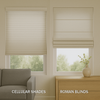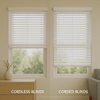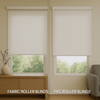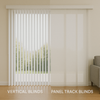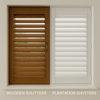Cellular Shades vs. Roman Blinds: Comfort, Insulation, and Style
- by Mariam Labadze
 Quick Answer
Quick Answer
Cellular shades feature honeycomb structures creating air pockets that provide exceptional insulation, reducing energy costs by up to 20% whilst offering clean, contemporary aesthetics. Roman blinds use fabric that folds into elegant horizontal pleats when raised, delivering luxurious appearance and design versatility suited to traditional and transitional interiors. Cellular options excel in energy efficiency, light filtering, and modern minimalist spaces, typically costing £60-£150 per window. Roman styles offer superior aesthetic impact, extensive fabric choices, and timeless elegance, usually ranging £80-£200 per window. Your choice depends on whether energy efficiency and function or visual impact and classic styling matter most for your specific rooms.
[toc]
Understanding the Structural Differences
-
Construction design – Cellular shades have honeycomb air pockets; Roman blinds feature flat fabric panels with horizontal folds
-
Insulation performance – Cellular structures trap air for superior thermal efficiency; Roman provides moderate insulation through fabric layers
-
Aesthetic appeal – Cellular suits modern, streamlined spaces; Roman delivers traditional elegance and luxury
-
Fabric variety – Roman offers virtually unlimited fabric options; Cellular provides practical selections optimized for function
-
Operating mechanisms – Both available in cordless, corded, or motorized; operation feels similar despite structural differences
-
Light control options – Cellular excels with sheer-to-blackout varieties; Roman offers similar range through fabric selection
-
Maintenance needs – Cellular requires occasional dusting; Roman may need professional cleaning depending on fabric choice
The Timeless Appeal of Roman Blinds
Roman blinds represent one of the most sophisticated and versatile window treatment options available, combining fabric's softness with the practicality of adjustable light control. These classic treatments have adorned windows for centuries, evolving from ancient Roman origins into modern designs that suit contemporary and traditional homes equally well.
The defining characteristic of Roman blinds lies in their elegant folding mechanism. When raised, fabric gathers into neat, horizontal pleats creating architectural interest even when the treatment is open. When lowered, the fabric hangs flat, presenting your chosen material in its full glory—whether that's a vibrant pattern, luxurious texture, or subtle solid color.
Unmatched Design Versatility – Roman blinds offer virtually unlimited fabric possibilities. Choose from cotton, linen, silk, velvet, jacquard, or blended materials in any color, pattern, or texture imaginable. This extensive selection allows perfect coordination with existing decor, making Roman blinds ideal for design-conscious homeowners who view window treatments as integral design elements rather than mere functional necessities.
Luxurious Aesthetic Impact – The soft fabric folds create depth and dimension impossible to achieve with flat treatments. This three-dimensional quality adds visual interest, casting subtle shadows that change throughout the day as natural light angles shift. The result feels sophisticated and intentional, elevating room aesthetics substantially.
Classic Style with Modern Function – Roman blinds bridge traditional and contemporary design beautifully. Classic fabrics and neutral colors suit period properties, whilst bold patterns or modern materials make striking statements in contemporary spaces. This versatility makes Roman blinds safe investments that remain stylish through evolving design trends.
Flexible Light Control – Raise Roman blinds partially for filtered light and privacy, or fully for maximum natural illumination. The graduated adjustment allows precise control throughout the day, managing changing light conditions without constantly moving between fully open or closed positions.
Enhanced Room Softness – Fabric's inherent warmth makes spaces feel more inviting than hard window treatments can achieve. Roman blinds soften architectural lines, reduce echo in rooms with hard surfaces, and contribute to comfortable, welcoming atmospheres that make houses feel like homes.
Understanding Cellular Shade Technology
Cellular shades, also called honeycomb shades, feature innovative construction designed specifically for thermal efficiency. The fabric forms distinctive hexagonal or honeycomb-shaped cells that trap air, creating insulating barriers significantly more effective than flat fabric or traditional treatments.
Single-cell designs offer good insulation whilst maintaining relatively slim profiles suitable for most window applications. Double-cell constructions provide even superior thermal performance, essentially doubling the insulating air pockets between interior and exterior glass surfaces.
The engineering behind cellular shades focuses primarily on energy efficiency rather than aesthetic impact. Whilst available in various colors and opacity levels, the design prioritizes function—reducing heat transfer, lowering energy costs, and improving comfort through stable indoor temperatures.
Modern cellular shades suit minimalist interiors where clean lines and unobtrusive design matter more than decorative impact. The streamlined appearance integrates seamlessly into contemporary spaces without commanding attention or competing with other design elements.
Light filtering capabilities range from sheer fabrics creating soft, diffused illumination to complete blackout materials for bedrooms requiring darkness. This functional variety addresses practical needs effectively, though the aesthetic presentation remains consistently understated regardless of opacity selection.
Roman Blinds: Style and Sophistication
Roman blinds transform windows into design focal points, offering aesthetic contributions that purely functional treatments cannot match. The fabric selection process becomes creative expression—choosing materials, colors, and patterns that reflect personal style whilst coordinating with broader interior design schemes.
Pattern and Color Freedom – Bold geometric patterns create modern drama, delicate florals enhance country cottage charm, rich damasks suit formal dining rooms, and playful prints delight children's spaces. Roman blinds accommodate any design vision through unlimited fabric possibilities, allowing personalization impossible with structured cellular alternatives.
Texture and Tactile Quality – Fabric texture adds sensory dimension to rooms. Smooth silks feel luxurious, natural linens bring organic authenticity, plush velvets create opulent warmth, and textured weaves add visual depth even in solid colors. This tactile quality enhances spatial experience beyond mere visual appeal.
Customization Options – Roman blinds accommodate various heading styles affecting how fabric gathers when raised. Flat Romans create clean, contemporary folds, whilst hobbled or relaxed styles introduce soft, cascading curves suited to traditional aesthetics. Edge treatments—contrasting borders, decorative trims, or clean finishes—further customize appearance matching specific design visions.
Layering Possibilities – Roman blinds layer beautifully with curtains or sheers, creating sophisticated window treatments addressing multiple needs. Deploy Romans for daytime privacy and light control, adding curtains for evening warmth, sound dampening, or theatrical impact when entertaining. This flexibility suits formal living spaces where window treatments contribute significantly to room ambiance.
Architectural Enhancement – Well-chosen Roman blinds enhance rather than merely cover windows. They frame views artistically, draw attention to beautiful window proportions, and can visually correct problematic architectural features—making small windows appear larger or unifying mismatched window sizes through consistent treatment style.
Energy Efficiency Comparison
Cellular shades dominate energy efficiency discussions, with honeycomb structures providing measurable thermal benefits. Studies demonstrate that quality cellular shades can reduce window heat loss by 40% or more during winter months, whilst blocking substantial solar heat gain during summer. These performance characteristics translate directly into lower heating and cooling costs.
The insulating properties prove particularly valuable in UK homes where weather varies dramatically throughout the year. Cold winters demand heat retention, whilst increasingly warm summers require solar heat rejection. Cellular shades address both seasonal challenges effectively through passive insulation requiring no energy consumption or active management.
Roman blinds offer more modest thermal benefits. Fabric layers create some insulation, particularly when treatments feature thermal linings or interlining adding bulk between glass and interior space. However, the performance falls short of cellular technology's engineered efficiency.
For rooms where energy efficiency matters critically—perhaps north-facing bedrooms that feel perpetually cold, or sun-drenched south-facing living areas becoming uncomfortably hot—cellular shades deliver measurably superior results justifying their selection despite aesthetic compromises.
However, Roman blinds paired with quality curtains or installed with thermal linings can achieve respectable energy performance whilst maintaining superior aesthetic appeal. This layered approach provides reasonable compromise for design-focused spaces where pure function shouldn't completely override style considerations.
Room-by-Room Application Guidance
Living Rooms and Formal Spaces – Roman blinds excel here, where aesthetics matter tremendously and window treatments contribute significantly to overall room presentation. The luxurious fabric, elegant folds, and design versatility justify selection even without cellular shades' energy advantages. Living rooms showcase your style to guests, making beautiful Roman blinds worthwhile investments.
Bedrooms – Roman blinds create restful, sophisticated atmospheres conducive to relaxation. The soft fabric feels appropriate for intimate spaces, whilst blackout linings provide darkness supporting quality sleep. Pattern and color choices personalize bedrooms uniquely, reflecting individual preferences in private spaces not requiring broader household consensus.
Dining Rooms – Roman blinds' formal elegance suits dining spaces perfectly. Rich fabrics, luxurious textures, and sophisticated colors enhance dining experiences, creating appropriate backdrops for entertaining guests or family meals. The treatments can adjust for bright morning breakfasts or ambient evening dinner parties.
Home Offices – Consider priorities carefully here. Cellular shades' light filtering reduces screen glare effectively whilst maintaining energy efficiency valuable in frequently used spaces. However, Roman blinds create more professional, finished appearances for video calls and provide aesthetic appeal making work environments pleasant during long hours.
Bathrooms – Roman blinds work beautifully in bathrooms when specified with moisture-resistant fabrics or water-repellent treatments. The soft aesthetic enhances spa-like atmospheres, whilst practical fabrics withstand humidity without problems. Choose lighter colors and washable materials for longevity in these high-moisture environments.
Kitchens – Roman blinds suit kitchens wonderfully, adding softness balancing hard surfaces like countertops, cabinets, and appliances. Select durable, easy-clean fabrics resisting stains and moisture. Patterns can introduce color and personality into often-neutral kitchen schemes dominated by white or wood tones.
Maintenance and Care Requirements
Roman blinds demand more maintenance attention than cellular alternatives, though requirements remain manageable with appropriate fabric selection and regular care. The maintenance level varies dramatically based on fabric choice—some materials prove remarkably forgiving, whilst others require professional cleaning.
Regular Maintenance – Dust Roman blinds weekly using vacuum attachments with soft brush heads or microfiber cloths. This prevents buildup that can embed in fabric fibers, making subsequent cleaning more difficult. Regular attention keeps blinds looking fresh whilst preventing minor soiling from becoming permanent staining.
Spot Cleaning – Address spills or marks immediately using gentle blotting rather than rubbing, which can spread stains or damage fibers. Use manufacturer-recommended cleaning solutions appropriate for your specific fabric type. Test cleaning products on inconspicuous areas first, ensuring they don't cause discoloration or damage.
Professional Cleaning – Many Roman blind fabrics benefit from periodic professional cleaning every 2-3 years, maintaining appearance and extending lifespan. Specialists understand how to clean delicate materials without shrinkage, color loss, or structural damage that DIY attempts might cause. This service costs £20-£40 per blind but preserves expensive treatments effectively.
Fabric Protection – Consider fabric protection treatments during manufacturing or applied professionally afterward. These protective coatings resist staining and moisture absorption, making maintenance significantly easier whilst extending fabric life in challenging environments like kitchens or family rooms.
Cellular shades require minimal maintenance—occasional dusting or gentle vacuuming keeps them looking pristine. The synthetic materials typically used resist staining and moisture, rarely requiring deep cleaning throughout their lifespans. This low-maintenance characteristic appeals to busy households or anyone preferring set-and-forget window solutions.
Cost Analysis and Investment Value
Roman blinds typically cost £80-£200 per standard window, with premium designer fabrics, custom sizes, or luxury materials pushing prices higher. This investment reflects quality fabric, skilled craftsmanship, and the bespoke nature of treatments manufactured specifically for your windows and specifications.
Cellular shades generally cost £60-£150 per window, making them moderately less expensive than Roman equivalents. The price difference reflects simpler construction and standard materials optimized for function rather than aesthetic variety.
However, pure cost comparison oversimplifies value assessment. Roman blinds contribute meaningfully to interior design, potentially elevating entire room aesthetics in ways that justify higher prices through enhanced daily enjoyment and potential property value increases.
The longevity of quality Roman blinds—often 10-15 years with proper care—amortizes initial costs over extended periods. When calculated as cost-per-year, the investment becomes more reasonable, particularly for rooms where you spend significant time and aesthetic quality directly impacts life quality.
Energy savings from cellular shades provide quantifiable returns offsetting initial costs. A home spending £2,000 annually on heating and cooling might save £200-£400 through cellular shades' superior insulation. Over the products' 10+ year lifespans, these savings total £2,000-£4,000—potentially exceeding initial investment entirely whilst providing ongoing comfort benefits.
Making Your Choice
Prioritize aesthetics and design impact? Roman blinds deliver unmatched beauty, versatility, and luxury that cellular shades cannot replicate. For living rooms, bedrooms, dining areas, or any space where window treatments significantly influence overall room success, Roman blinds justify their selection and investment.
Energy efficiency your primary concern? Cellular shades provide measurably superior thermal performance reducing energy costs substantially. For budget-conscious households, energy-intensive spaces, or anyone prioritizing environmental responsibility, cellular shades deliver practical benefits that pure aesthetics cannot match.
Consider hybrid approaches for homes with diverse needs. Install Roman blinds in showcase areas—living rooms, master bedrooms, formal dining rooms—where aesthetic impact matters tremendously. Use cellular shades in utility spaces, home offices, or secondary bedrooms where function outweighs appearance, directing budget toward beautiful treatments where visual impact matters most.
At 1 Click Blinds, Roman blinds offer timeless elegance and design versatility that transform windows into stunning focal points whilst providing practical light control and privacy. Whether you choose classic patterns complementing traditional decor or contemporary fabrics enhancing modern spaces, quality Roman blinds enhance your home beautifully for years whilst delivering the comfort, style, and functionality that make daily living more enjoyable.

